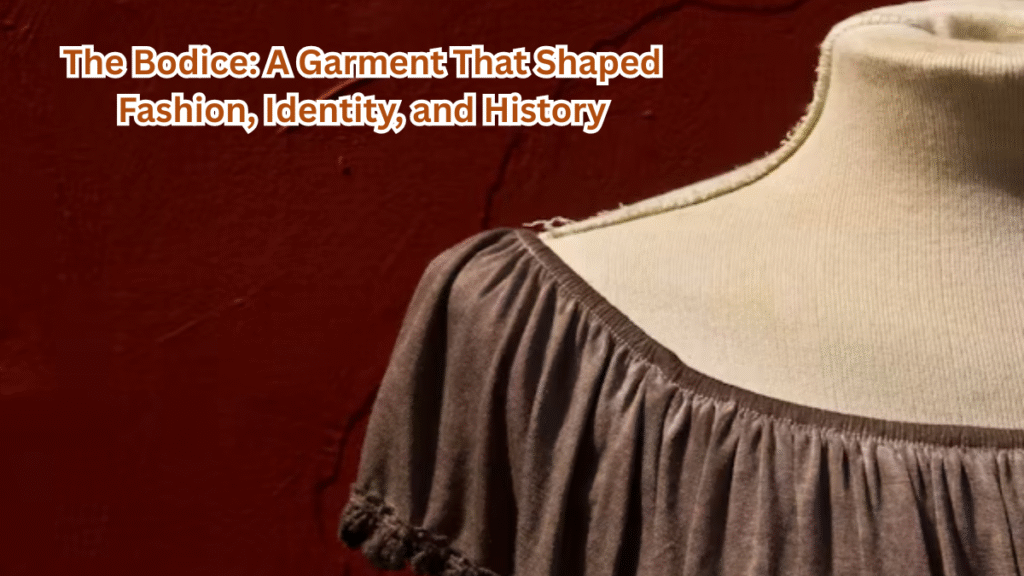The bodice is more than just a piece of fabric stitched to cover the torso—it is one of the most enduring, symbolic, and evolving garments in the history of fashion. From its medieval beginnings to its reinvention in contemporary couture and streetwear, the bodice has been central to how people—especially women—have expressed identity, status, and aesthetics. At its core, the bodice represents the intersection of structure and freedom: it restricts, it enhances, it empowers, and it reflects the cultural narratives of its time.
In this article, we will explore the bodice’s remarkable journey, uncovering its transformation across centuries, its role in shaping gender expression, and how it continues to influence fashion design today.
What Is a Bodice?
A bodice is traditionally the upper part of a dress or a separate garment covering the torso, often tailored to fit snugly. It may extend from the shoulders to the waist or hips, depending on the style, and historically, it was often structured with boning, laces, or stays to mold the body.
Key defining aspects of the bodice include:
- Torso coverage: Extends from neckline to waist.
- Structured fit: Frequently reinforced to create a specific silhouette.
- Design variations: Can be strapless, sleeved, laced, buttoned, or zippered.
- Cultural symbolism: Often a signifier of social status, femininity, and beauty ideals.
A Timeline of the Bodice
To understand the bodice fully, one must look at its evolution through history:
| Era | Characteristics | Social Significance |
|---|---|---|
| Medieval (12th–15th century) | Laced tunics and surcoats resembling early bodices. | Symbolized modesty and class. |
| Renaissance (15th–17th century) | Stiffened, V-shaped bodices with rich embroidery. | Expressed wealth and refinement. |
| Baroque & Rococo (17th–18th century) | Corseted bodices, low necklines, wide skirts. | Defined courtly elegance and femininity. |
| Victorian (19th century) | Tight corseted bodices with high collars. | Enforced ideals of modesty and morality. |
| Edwardian (early 20th century) | “S-curve” bodices with softer shaping. | Blended restraint with modern movement. |
| 20th century | From structured corsetry to liberated flapper bodices. | Reflected women’s emancipation. |
| 21st century | Bodices as stand-alone fashion statements, often reimagined. | Symbol of empowerment and creativity. |
The Renaissance of Shape and Structure
The Renaissance was perhaps the golden age of the bodice. Fashionable bodices were stiffened with wood, reed, or whalebone stays, creating a conical torso shape. Richly decorated with pearls, velvet, and brocade, these garments were meant to impress both visually and socially.
Courts across Europe, from Florence to London, set the standard. A high-born lady’s bodice was a declaration: of lineage, wealth, and social superiority.
A courtier once wrote:
“A lady’s stature is not in her bearing, but in the elegance of her bodice, which frames her essence.”
The Bodice as Social Control
As much as the bodice celebrated beauty, it was also a tool of control. Corseted bodices restricted breathing and movement. They reinforced not only posture but also social expectations—particularly for women.
- Restriction: Bodices limited women’s physical freedom.
- Class marker: Stiff, embroidered bodices were affordable only to the elite.
- Moral expectations: Covering the torso was equated with modesty and virtue.
This paradox—empowerment through beauty and oppression through structure—has defined much of the garment’s history.
Revolution in the 19th and 20th Centuries
The industrial revolution brought mass production, making bodices accessible beyond the aristocracy. At the same time, women’s movements were questioning restrictive clothing. The bodice began to adapt.
- Victorian bodices emphasized upright modesty with high collars and cinched waists.
- Edwardian designs softened into the “S-curve” silhouette, signaling early liberation.
- 1920s flapper bodices abandoned corsetry altogether, celebrating straight, boyish lines.
By the mid-20th century, designers like Christian Dior reintroduced structured bodices in the “New Look,” with cinched waists and voluminous skirts—a blend of nostalgia and modernity.
Fashion historian Amelia Roth observed:
“The bodice became a battlefield of ideals—liberation versus tradition, comfort versus spectacle, individuality versus conformity.”
The Bodice Today
In contemporary fashion, the bodice has taken on new meanings. It is no longer a garment of oppression but one of statement and creativity.
Modern designers reinterpret bodices through:
- Runway couture: Structured bodices as architectural masterpieces.
- Everyday fashion: Cropped bodices paired with jeans or skirts.
- Bridal wear: Lace or satin bodices remain central in wedding gowns.
- Pop culture: Celebrities wear bodices as bold, empowering outfits.
Today’s bodices blend structure with comfort. Stretch fabrics, hidden zippers, and innovative tailoring allow freedom of movement while celebrating the silhouette.
As designer Stella Huang once said:
“The bodice is no longer about containment. It is about celebration—the torso as canvas, the body as art.”
Cultural and Symbolic Layers
Beyond fashion, the bodice has symbolic power:
- Femininity and identity: It reflects shifting ideals of womanhood.
- National costume: From dirndls in Bavaria to cholis in South Asia, bodice-like garments remain cultural staples.
- Gender expression: In modern fashion, bodices are worn by all genders, challenging binary clothing norms.
- Empowerment: Worn intentionally, bodices now reclaim agency—an inversion of their restrictive past.
The Craft of Making a Bodice
The bodice has always been a tailor’s challenge. Its construction requires precision, as it must fit the torso perfectly.
Elements of bodice construction:
- Pattern drafting: Careful measurement ensures accuracy.
- Boning/stays: Provide structure and shape.
- Seams and darts: Essential for contouring the garment to the body.
- Fabrics: Historically silk, velvet, brocade; today cotton, synthetics, and blends.
A master seamstress once explained:
“A bodice is the closest garment to the heart. Every stitch must honor both the body and the spirit.”
Why the Bodice’s Still Matters
The bodice matters not because it is a relic, but because it is alive in fashion. Its endurance across centuries proves its adaptability. Whether as historical costume, bridal gown, or streetwear crop top, it continues to reflect the tension between tradition and reinvention.
Its persistence asks us deeper questions:
- How does clothing shape identity?
- What is the balance between restriction and expression in fashion?
- Why do garments carry such cultural weight?
The bodice is not just fabric and stitches. It is a mirror of society.
FAQs About the Bodice
1. What is the difference between a bodice and a corset?
A bodice is the general torso-covering garment, while a corset is a specific structured undergarment designed to shape the waist. Some bodices incorporate corset-like elements, but not all bodices are corsets.
2. Is the bodice still used in modern fashion?
Yes. Bodices appear in wedding dresses, couture fashion, traditional cultural attire, and contemporary streetwear, often in reinvented forms.
3. Was wearing a bodice uncomfortable in history?
Many historical bodices were restrictive, especially those stiffened with boning or whalebone stays. Comfort varied depending on class, occasion, and design.
4. How do designers reinterpret the bodice today?
Modern designers use stretch fabrics, zippers, and innovative tailoring to combine structure with comfort, making the bodice a fashion-forward statement.
5. What cultural garments resemble the bodice?
Examples include the dirndl bodice in Bavaria, the choli in South Asia, and fitted bodices in traditional European folk costumes.







